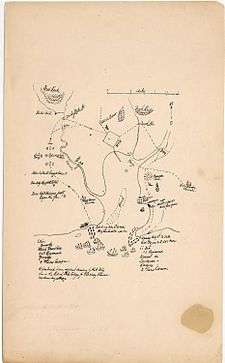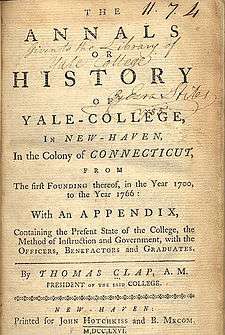Ezra Stiles
| Ezra Stiles | |
|---|---|
 Rev. Ezra Stiles, 1770-1771, by Samuel King | |
| 7th President of Yale University | |
|
In office 1778–1795 | |
| Preceded by |
Naphtali Daggett as pro tempore |
| Succeeded by | Timothy Dwight IV |
| Personal details | |
| Born |
December 10, 1727 North Haven, Connecticut |
| Died |
May 12, 1795 (aged 67) New Haven, Connecticut |
| Children | Betsey Stiles; Ruth (Stiles) Gannett; Emilia (Stiles) Leavitt; Polly (Stiles) Holmes; Isaac Stiles |
| Signature |
|
Ezra Stiles (December 10, 1727[1] – May 12, 1795) was an American academic and educator, a Congregationalist minister, theologian and author. He was seventh president of Yale College (1778–1795), and one of the founders of Brown University.[2][3]
Early life

Born the son of the Rev. Isaac Stiles in North Haven, Connecticut,and Kezia Taylor 1702-1727.(Find a grave) Ezra Stiles graduated from Yale in 1746. He studied theology and was ordained in 1749, tutoring at Yale from that year until 1755. He resigned from the ministry in 1753 to study law and practice at New Haven, but returned to the cloth two years later. Historians Helen A. Lane and Marion B. Walkden report that he was the first minister of the Dighton Community Church in Massachusetts. They state:
Ezra Stiles, first settled minister of the church, was later made president of Yale College. Driven out by the British in 1777, he arrived in Dighton with his family and several of his former Newport congregation. Among them was William Ellery, singer (sic) of the Declaration of Independence. Ezra as minister of the half finished church at Lower Four Corners was paid about three hundred dollars, house, and wood. While minister of the Dighton Church, Ezra Stiles received on July 13th a copy of the Declaration of Independence to be read to the congregation. It was brought to him by Mr. Channing, father of the famous preachers. Among Rev. Stiles’ many friends were Benjamin Franklin, Robert J. Payne, General Stark, John Adams, President Langdon of Harvard, and many leaders of the Revolutionary War period."[4]
In 1784, Stiles was elected an honorary member of the Society of the Cincinnati of Connecticut, one of the first so honored, for his ardent support of the Patriot cause.
Newport life
Trinity Church, the Anglican Church in Newport, Rhode Island, asked him to become its minister, but he turned the offer down. Instead, in 1755, he became pastor of the Second Congregational Church, also in Newport, where he also served as Librarian of the Redwood Library and Athenaeum. He kept an informative diary of his life and distinguished acquaintances in Newport, including his association with Aaron Lopez. Newport's Ezra Stiles House is on the National Historic Register.
From time to time, Stiles invested with the merchants and sea captains of his congregation; in 1756, he sent a hogshead of rum along on a voyage to Africa and was repaid with a 10-year-old male slave, whom he renamed "Newport". Around the same time, he wrote a joint letter with fellow Newport minister Samuel Hopkins condemning "the great inhumanity and cruelty" of slavery in the United States.[5]
Foundation of Brown University
In 1764, Stiles helped establish the College in the English Colony of Rhode Island and Providence Plantations (the original name for Brown University) by contributing to the drafting of its charter and by serving with 35 others—including Stephen Hopkins, William Ellery, Samuel Ward, the Reverend John Gano, the Reverend Isaac Backus, the Reverend Samuel Stillman, and the Reverend James Manning—as a founding fellow or trustee.[6]
Biblical scholarship
Stiles struck up a close friendship with Rabbi Haim Isaac Carigal during the latter's six-month residence in Newport in 1773. Stiles' records note 28 meetings to discuss a wide variety of topics from Kabbalah to the politics of the Holy Land. Stiles improved his rudimentary knowledge of Hebrew, to the point where he and Carigal corresponded by mail in the language.
Stiles' knowledge of Hebrew also enabled him to translate large portions of the Hebrew Old Testament into English. Stiles believed, as did many Christian scholars of the time, that facility with the text in its original language was advantageous for proper interpretation.
American Revolution

When British troops arrived in Newport in late 1776, Stiles left. He became pastor of the Congregational Church at Portsmouth, New Hampshire, in 1777.
Yale presidency

In 1778, he was appointed president of Yale, a post he held until his death. Stiles freed Newport on June 9, 1778, as he prepared to move to New Haven; he would in 1782 hire his former slave for $20 a year and the indenturing of Newport's two-year-old son until age 24.[5] As president of Yale, Stiles became its first professor of Semitics, and required all students to study Hebrew (as Harvard students already did); his first commencement address in September 1781 (no ceremonies having been held during the American Revolutionary War) was delivered in Hebrew, Aramaic, and Arabic. By 1790, however, he was forced to face failure in instilling an interest in the language in the student body, writing
- "From my first accession to the Presidency ... I have obliged all the Freshmen to study Hebrew. This has proved very disagreeable to a Number of the Students. This year I have determined to instruct only those who offer themselves voluntarily."
The valedictorians of 1785 and 1792, however, did deliver their speeches in Hebrew.
Stiles was an amateur scientist who corresponded with Thomas Jefferson and Benjamin Franklin about scientific discoveries. Using equipment donated to the college by Franklin, Stiles conducted the first electrical experiments in New England. He was elected a Fellow of the American Academy of Arts and Sciences in 1781.[7]
His book The United States elevated to Glory and Honor was printed in 1783.[8]

Legacy at Yale
Yale's legacy from this interest of Stiles' includes a portrait of Carigal by artist Samuel King. The idea that the Hebrew words "Urim" and "Thummim" (אורים ותמים) on the Yale seal are there because of Ezra Stiles is a false myth. Indeed, the Hebrew on the Yale seal appears on Stiles' own master's degree diploma from Yale in 1749, decades before he became president of Yale College.[9]
In 1961, Yale named a new residential college in his honor: Ezra Stiles College, noted for its Eero Saarinen design, particularly the building's lack of right angles between walls. The college's mascot is the moose, inspired by the installation in the dining hall of a stuffed moose head in honor of former college master and Yale president A. Bartlett Giamatti. Adjacent to Ezra Stiles College is its near architectural twin, Morse College, named for Samuel F.B. Morse.
Personal life
Stiles married twice (Elizabeth Hubbard and Mary Checkley Cranston) and had eight children. Stiles' son Ezra Stiles, Esq., was educated first at Yale College, then at Harvard College, where he studied law, graduating in 1778. Ezra Stiles, Jr., subsequently settled in Vermont, and served to establish the boundaries between Vermont and New Hampshire. He died prematurely at Chowan County, North Carolina, on Aug. 22, 1784, and his two daughters by his wife Sylvia (Avery) Stiles of Vermont (and formerly of Norwich, Connecticut) had their uncle Jonathan Leavitt appointed their guardian.[10]
His daughter Emilia married Judge and State Senator Jonathan Leavitt of Greenfield, Massachusetts. His daughter Mary married, in 1790, Abiel Holmes, a Congregational clergyman and historian and a 1783 graduate of Yale College. By the second marriage to Sarah Wendell, Abiel was the father of Oliver Wendell Holmes, Sr.
References
- ↑ Holmes, Abiel (1798). The Life of Ezra Stiles ... President of Yale College, p. 9.
- ↑ Welch, Lewis et al. (1899). Yale, Her Campus, Class-rooms, and Athletics, p. 445.
- ↑ Edmund S Morgan, The Gentle Puritan: A Life of Ezra Stiles, 1727-1795 (New York: W. W. Norton & Company, 1962), 205.
- ↑ http://dightoncommunitychurch.com/churchhistory.html
- 1 2 Dugdale, Antony; J. J. Fueser; J. Celso de Castro Alves (2001). "Ezra Stiles College". Yale, Slavery, & Abolition. The Amistad Committee. Retrieved December 12, 2012.
- ↑ "Brown University Charter" (PDF).
- ↑ "Book of Members, 1780–2010: Chapter S" (PDF). American Academy of Arts and Sciences. Retrieved July 28, 2014.
- ↑ "The United States Elevated to Glory and Honor".
- ↑ Oren, Dan A. (2001) Joining the Club: A History of Jews and Yale, Revised edition, p. 347.
- ↑ The Stiles Family in America, Genealogies of the Connecticut Family, Henry Reed Stiles, Doan & Pilson, Jersey City, 1895
Further reading
- Dexter, Franklin Bowditch. (1901). The Literary Diary of Ezra Stiles (Vol. I, January 1, 1769 – March 13, 1776). New York: Charles Scribner's Sons.
- __________. (1901). The Literary Diary of Ezra Stiles Vol. II, March 14, 1776-December 31, 1781. New York: Charles Scribner's Sons. OCLC 2198912
- __________. (1901). The Literary Diary of Ezra Stiles (Vol. III, January 1, 1782 – May 6, 1795). New York: Charles Scribner's Sons.
- Holmes, Abiel. (1798). The Life of Ezra Stiles D.D. LL.D. ... President of Yale College. Boston: Thomas & Andrews. OCLC 11506585
- Kelley, Brooks Mather. (1999). Yale: A History. New Haven: Yale University Press. ISBN 978-0-300-07843-5; OCLC 810552
- Morgan, Edmund Sears. (1983). The Gentle Puritan: A Life of Ezra Stiles, 1727-1795. The gentle puritan: a life of Ezra Stiles, 1727-1795. Raleigh: University of North Carolina Press. ISBN 978-0-8078-1231-0
- Welch, Lewis Sheldon and Walter Camp. (1899). Yale, Her Campus, Class-rooms, and Athletics. Boston: L. C. Page and Co. OCLC 2191518
External links
| Academic offices | ||
|---|---|---|
| Preceded by Naphtali Daggett, pro tempore |
President of Yale College 1778–1795 |
Succeeded by Timothy Dwight IV |